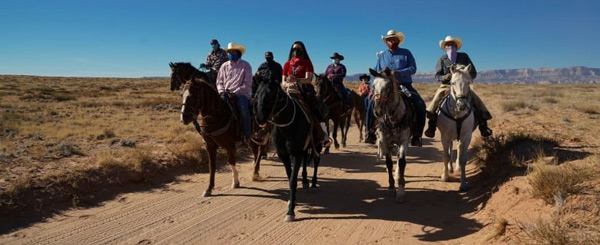National News
THEY RODE THE POLLS

Leading Navajo Nation voters to the polls by Horseback
‘It’s really about motivating our Native youth,’ says Allie Young of Protect the Sacred
Allie Young is mounted on horseback and decked out in traditional Diné attire as she leads her people through the desert to the polls.
The Navajo Nation was a powerful voting bloc in Tuesday’s U.S. presidential election, and Young wants to make sure its members are heard. She believes there aren’t enough polling stations available to voters on the nearly 70,000 square kilometres of land that spans Arizona, New Mexico and Utah.
“To be on horseback is to reconnect with our culture, and it’s really about motivating our Native youth who are always inspired by our elders and our ancestors, and especially what they fought for — for us to be here today and also have a right to vote,” Young, 30, co-founder of the non-profit Protect the Sacred, told As It Happens host Carol Off.
Through Protect the Sacred, she launched “Ride The Polls” in October. She’s led two small groups of riders to the polls for early voting in Arizona, and is taking one last journey on election day.
“There were moments where it was quiet and serene and peaceful. And there were moments where we were chatting and reconnecting as a community,” Young said.
“It’s a very spiritual feeling because we’re in our homeland where we’re reminded of what we’re fighting for, and that’s to protect not only our community and our people, but our Mother Earth and our sacred homeland.”
Systemic barriers to voting
Young initially co-founded Protect the Sacred to help Indigenous communities disproportionately affected by the coronavirus pandemic. The organization has since launched projects to help people fill out the 2020 Census, and to register to vote.
Native Americans could not vote in every state until 1962, and there continue to be systemic barriers today, including a dearth of accessible polling stations and post offices.
Logistical hurdles aside, Young says she knew she had to tap into something powerful to motivate people to vote — especially Indigenous youth.
“They were feeling frustrated with the system and in the way that Native people are being treated in the United States by our federal government. And most recently, it’s COVID-19 and how the funding was delayed to tribal nations,” she said.
In May, the Navajo Nation announced it had the highest per capita COVID-19 infection rate in the United States, outpacing even New York City.
When the federal response lagged, Doctors Without Borders sent a team of health-care workers to the nation, a rare move for an organization that usually sticks to war zones.
“Our Native youth who are feeling like, ‘Why are we going to continue participating in this colonial system that has never worked for us?’ And that’s a completely valid point, which I agree with,” Young said.
“But at the same time, this is one of the most important elections of our lifetime. And in order to make the changes that we want to see, we have to elect leaders and officials who will invite us to the table and invite us into conversations about how we want to lead our own community.”
And they have the power to affect the results. According to the Washington Post, there 67,000 eligible Navajo voters in Arizona, which is a swing state.
“It’s a little odd to see, I guess, or surprising to see the attention that we were given this election. The Trump administration has visited tribal leaders in Arizona three or four times in the last few months since the pandemic, which is highly unusual,” she said.
“To me, that says that they know we have this voting force.”
While Ride The Polls is about the Navajo Nation as a whole, Young says it’s also deeply personal.
She has been leading the rides alongside her father. The two of them have been riding together her whole life, she said.
“It’s something that’s kind of our thing and the way that we bond. And he told me that he hasn’t been really motivated or activated to ride recently. He has become, you know, tired and exhausted,” Young said. “This really got him out, and he’s really excited.”
Before her last journey, Young’s mother tied a Diné sash, traditionally used in childbirth, around Young’s waist and adorned her in turquoise beaded jewelry.
“They’re proud and they’re excited to see that we’re inspiring not only Native youth in our Native communities across the country, but other communities of colour who’ve reached out and thanked us for our efforts.”
Written by Sheena Goodyear. Interview produced by Katie Geleff.